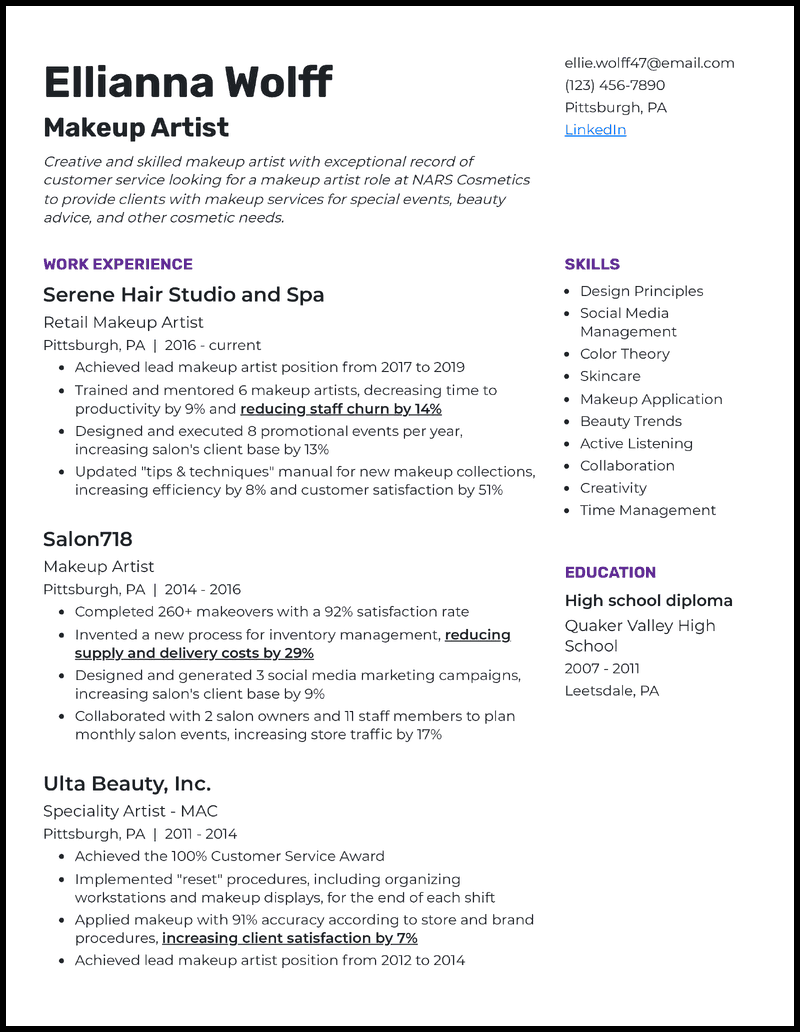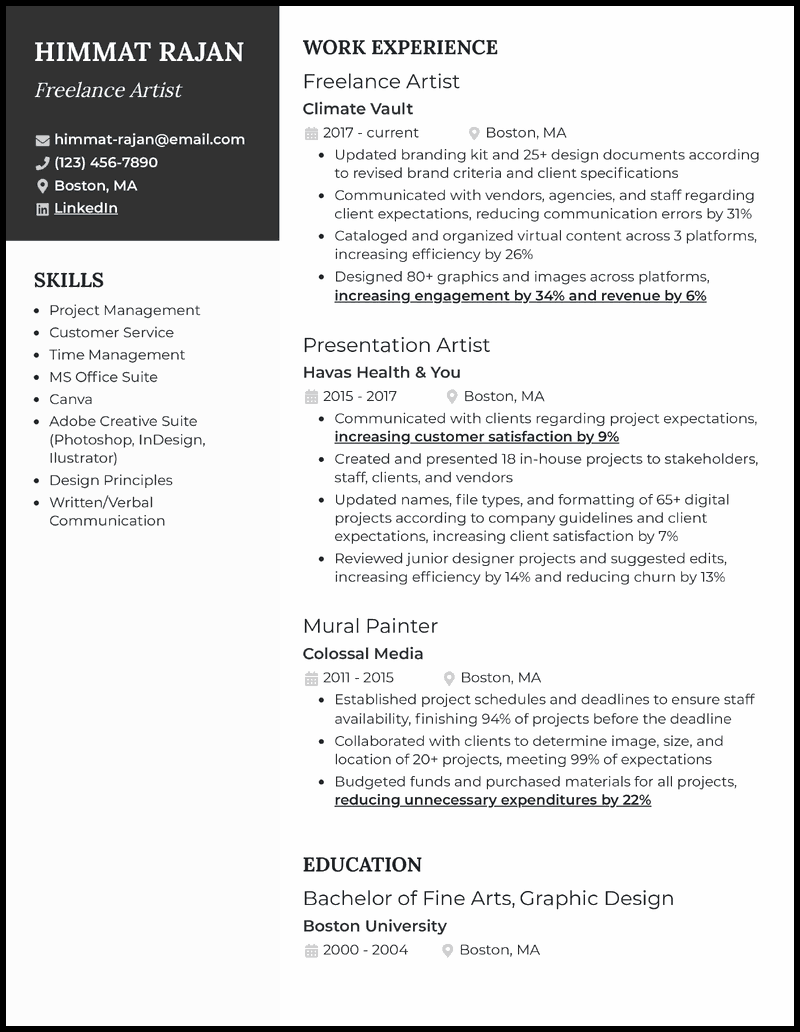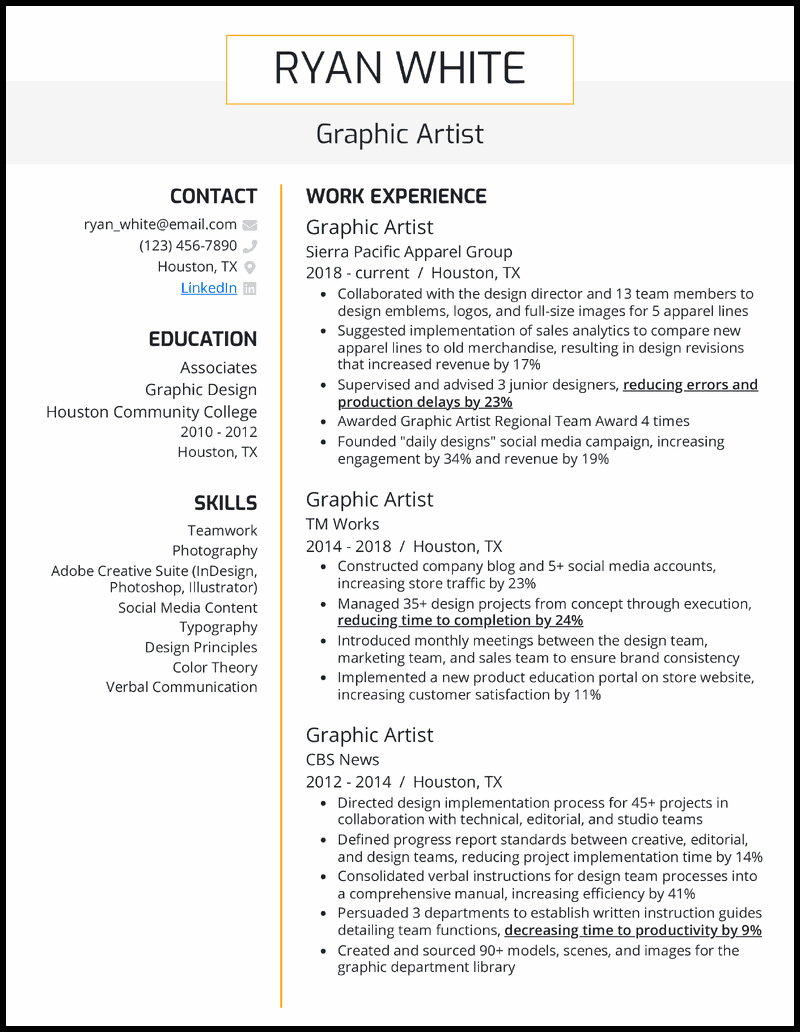
Artist





Best for candidates with 3+ years of experience
Resume Builder
Like this template? Customize this resume and make it your own with the help of our Al-powered suggestions, accent colors, and modern fonts.
Art is a universal language. Regardless of the medium you use or the type of art you create, your creative abilities, professionalism, and overall talent make the world a brighter, more beautiful place.
If you’re ready to embark on your next career adventure, you may be wondering whether a cover letter generator really works and how to write a compelling resume. How are you supposed to know what hiring managers want in an ideal candidate?
We know that writing CVs isn’t easy, which is why we’ve scoured through hundreds of CVs to determine what gets you a job versus what doesn’t. Our seven sample artist CVs are the culmination of our research to help you get inspired and create a CV that gets you hired.
Why this CV works
- As a professional artist, you know the importance of demonstrating your abilities from the get-go. When it comes to your artist resume, a resume summary is a quick way to showcase your skills and experience before the recruiter even glances at your work experience.
- If you have any qualifications or special achievements, now is the time to mention them! You should also list your years of experience and the name of the employer.
- Demonstrating your measurable impact will help you stand out and be hired, so include numbers (also called metrics) where you can.
- For example, good metrics for your artist’s CV might include increases in art sales, the amount of repeat business, or the amount of money you saved.
Why this CV works
- The skills section of your resume is the opportunity to list critical areas you feel are your most significant assets.
- Good skills to add would be “colour theory,” “make-up application,” “skincare,” and “teamwork.”
- Whenever you submit your CV, be sure to tailor your CV to the job description.
- For example, if the job description repeatedly mentions make-up application for special occasions, you should include your experience applying make-up for significant events like school proms, weddings, and birthdays.
- You should also include repeated keywords you see in the job description, such as “product knowledge” and “achieve sales objectives,” try to incorporate similar keywords in your makeup artist CV.
View more makeup artist resumes >
Why this CV works
- How realistic were your animated characters? Animation fans want something closer to real life and that’s where you can make your animator CV stand out.
- Demonstrate, with numerical evidence, in both your artist cover letter and CV how your animation projects provided the most realistic experiences, and you’ll be the candidate that recruiters will seek out.
Why this CV works
- As an artist, your success can only come from the appreciation of your work. Have you received more invitations to art exhibitions and recognition from the art community? Brilliant. Highlight that in your painter CV.
- To ensure that potential employers get a sense of your abilities, highlight your growing sales figures.
Why this CV works
- You want your freelance artist CV to secure you a job, so you obviously want to include as much as you can on one page, so use your space wisely.
- Use sentence fragments for your work experience bullet points and don’t worry about ending punctuation (although commas are encouraged).
- Avoid using adjectives or the word “skills” in your skills section as they’re redundant.
- If it comes to choosing between adding an optional section (such as an objective or summary) and adding more work experience, add work experience.
- When formatting your resume, remember that your goal isn’t just to fill the page with relevant content; it’s also to make your CV easy to read.
- To ensure your CV is easy to skim, choose margins that are one inch all around and keep your font size large (but not enormous).
View more freelance artist resumes >
Why this CV works
- Hiring managers typically only spend seven seconds reading your resume, which means you have minimal time to show them what you can do. To make their job easier, use action verbs at the beginning of your work experience bullet points.
- Action words eliminate the waffle and emphasise your achievements right from the start.
- Words such as “founded,” “directed,” “awarded,” “managed,” and “created” are great examples of action words.
- Your graphic designer CV is your prospective employer’s first impression of you, so you need to ensure your CV is completely free of errors and slip-ups.
- Before you submit your application, check your resume for grammar errors, typos, and inaccuracies. If you can, ask a colleague to review your CV as well, as they’ll be able to spot mistakes that you and AI might have missed.
Why this CV works
- To impress recruiters quickly, use a resume objective to tell the hiring manager your years of experience, your skills, and what you’re looking to accomplish if you’re hired.
- Always tailor this section to the job description by including the company name and position. If you don’t have time to tailor it, omit it in favour of more work experience instead.
- Your abilities should shine in your work experience, but you still need to include your education on your fine artist CV.
- Even if you only have a secondary school diploma, employers want to know that you’ve completed some further education. If you have a university degree, you can omit your secondary school diploma (although if you have a postgraduate degree, include both your undergraduate and postgraduate degrees separately).
View more fine artist resumes >
How to Write an Artist CV

Naturally, you want to stand out in the competitive art world. A well-crafted artist CV can make that happen. Whether you’re aiming for gallery representation, group or individual grants, or freelance opportunities, this guide will show you how to write an artist CV that grabs attention and gets you where the action is. Let’s break it down one step at a time.

Keep your CV formatting simple and functional
Avoid over-styling. Keep your format clean and readable with fonts like Arial or Calibri in 10–12pt size. Clearly display the headings and use concise bullet points to structure your CV. One page is sufficient unless you have extensive experience worth sharing. Recruiters and curators skim—so make it easy to scan at a glance.

Add contact details
Begin your CV with your first and last name, professional title (e.g., Visual Artist, Illustrator, Sculptor), phone number, professional email, website/portfolio, and LinkedIn (only if relevant). Example:
Peter Mayers
Illustrator
[email protected] | 01234 567890
www.parts.co.uk | @peterarts

Summarise your career
Begin with a two to three-sentence summary statement highlighting your work, career goals, and key achievements. Be concise and engaging.
Example:
Contemporary visual artist with over 8 years of experience exhibiting in solo and group shows across the UK. Renowned for large-scale abstract paintings exploring identity and emotion. Featured in ArtForum and recipient of the 2024 Promising Artist Grant.

Highlight relevant artwork experience
Create a lasting first impression with your exhibitions, freelance work, commissions, or group projects. Highlight achievements with impact—mention gallery names, dates, awards, and press coverage. Tailor each experience to the opportunity you’re applying for.
Examples by genre:
Visual Artist
Solo Exhibition, “Shreds of Grey” – MoMA PS1, NYC (2024)
- Attracted over 3,000 visitors in one month
- Featured in ArtNews Top 10 London Exhibitions of the Year
Illustrator
Assistant Illustrator – “Stranger Lands” Graphic Novel (2021)
- Illustrated 212 pages in full colour
- The book sold 14,000 copies in the first six months.
Multimedia Artist
Interactive Installer – “Room Echo” at SXSW (2019)
- Integrated projection mapping and sound design
- Won Best Experimental Media Award
Freelance Commissioned Work
Freelance Portrait Artist (2017–2019)
- Delivered 152 bespoke digital portraits
- 4.8/5 client rating on Etsy, 2.5K followers on Instagram

Include your education
Include your degrees, certifications, and any relevant workshops or placements. If you’re a recent graduate, add your degree classification (if it is a 2:1 or above), honours, awards, and relevant modules or projects.
Example:
BA in Fine Arts, School of the Art Institute of Chicago, 2016
- Graduated with Honours, Degree Classification: 2:1
- Coursework: Contemporary Painting, Digital Illustration, History of Art
- Final Year Dissertation: “Art & Identity in the Digital Age”
Artist CV FAQs

A professional artist CV should be as visually appealing as your work. Use a well-spaced template and mention your best work experiences, whether working independently or for an agency. Also, don’t forget to add your best colour/sketching/painting skills and educational background.
A good artist CV should be able to demonstrate the success and uniqueness of your career. From workplace achievements to winning competitions, include everything that sets you apart from the average artist to create an impressive CV.
A CV summary for an artist is the quickest way to showcase what you can do, including your past achievements, skills, and career goals. It’s an overview of your strengths and qualifications, making it easy for recruiters to understand your value without spending too much time on your CV. Therefore, when you write your summary statement as an artist, make it concise and impactful.
It’s the space on your CV that showcases what you can do as an artist. It demonstrates your unique qualities and expertise that make your art worth the consideration of hiring teams. When you create the skills section, include keywords from the job advert and relevant phrases from the art sector.




![7 Artist CV Examples [& Templates]](https://beamjobs.wpenginepowered.com/wp-content/uploads/2024/01/artist-resume.png)










